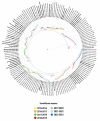Molecular Epidemiology and Genetic Diversity of Human Respiratory Syncytial Virus in Sicily during Pre- and Post-COVID-19 Surveillance Seasons
- PMID: 37764907
- PMCID: PMC10534943
- DOI: 10.3390/pathogens12091099
Molecular Epidemiology and Genetic Diversity of Human Respiratory Syncytial Virus in Sicily during Pre- and Post-COVID-19 Surveillance Seasons
Abstract
Human respiratory syncytial virus (hRSV) is an important pathogen of acute respiratory tract infection of global significance. In this study, we investigated the molecular epidemiology and the genetic variability of hRSV over seven surveillance seasons between 2015 and 2023 in Sicily, Italy. hRSV subgroups co-circulated through every season, although hRSV-B mostly prevailed. After the considerable reduction in the circulation of hRSV due to the widespread implementation of non-pharmaceutical preventive measures during the COVID-19 pandemic, hRSV rapidly re-emerged at a high intensity in 2022-2023. The G gene was sequenced for genotyping and analysis of deduced amino acids. A total of 128 hRSV-A and 179 hRSV-B G gene sequences were obtained. The phylogenetic analysis revealed that the GA2.3.5a (ON1) and GB5.0.5a (BA9) genotypes were responsible for the hRSV epidemics in Sicily.; only one strain belonged to the genotype GB5.0.4a. No differences were observed in the circulating genotypes during pre- and post-pandemic years. Amino acid sequence alignment revealed the continuous evolution of the G gene, with a combination of amino acid changes specifically appearing in 2022-2023. The predicted N-glycosylation sites were relatively conserved in ON1 and BA9 genotype strains. Our findings augment the understanding and prediction of the seasonal evolution of hRSV at the local level and its implication in the monitoring of novel variants worth considering in better design of candidate vaccines.
Keywords: BA9; GA2.3.5a; GB5.0.4a; GB5.0.5a; Italy; ON1; Sicily; genotype; hRSV-A; hRSV-B; molecular epidemiology.
Conflict of interest statement
The authors declare no conflict of interest.
Figures





Similar articles
-
Whole-Genome Sequencing and Genetic Diversity of Human Respiratory Syncytial Virus in Patients with Influenza-like Illness in Sicily (Italy) from 2017 to 2023.Viruses. 2024 May 26;16(6):851. doi: 10.3390/v16060851. Viruses. 2024. PMID: 38932144 Free PMC article.
-
Genetic Diversity of Human Respiratory Syncytial Virus during COVID-19 Pandemic in Yaoundé, Cameroon, 2020-2021.Microorganisms. 2024 May 8;12(5):952. doi: 10.3390/microorganisms12050952. Microorganisms. 2024. PMID: 38792782 Free PMC article.
-
Predominance of ON1 and BA9 genotypes of human respiratory syncytial virus in children with acute respiratory infection in Chiang Mai, Thailand, 2020-2021.J Infect Public Health. 2023 Sep;16(9):1418-1426. doi: 10.1016/j.jiph.2023.07.009. Epub 2023 Jul 20. J Infect Public Health. 2023. PMID: 37482015
-
Genetic variability human respiratory syncytial virus subgroups A and B in Turkey during six successive epidemic seasons, 2009-2015.J Med Virol. 2018 Mar;90(3):456-463. doi: 10.1002/jmv.24983. Epub 2017 Dec 6. J Med Virol. 2018. PMID: 29077212 Free PMC article.
-
Characterization of human respiratory syncytial virus in children with severe acute respiratory infection before and during the COVID-19 pandemic.IJID Reg. 2024 Mar 21;11:100354. doi: 10.1016/j.ijregi.2024.03.009. eCollection 2024 Jun. IJID Reg. 2024. PMID: 38596821 Free PMC article. Review.
Cited by
-
Whole-Genome Sequencing and Genetic Diversity of Human Respiratory Syncytial Virus in Patients with Influenza-like Illness in Sicily (Italy) from 2017 to 2023.Viruses. 2024 May 26;16(6):851. doi: 10.3390/v16060851. Viruses. 2024. PMID: 38932144 Free PMC article.
-
Identification of distinct genotypes in circulating RSV A strains based on variants on the virus replication-associated genes.bioRxiv [Preprint]. 2024 Apr 23:2024.04.22.590570. doi: 10.1101/2024.04.22.590570. bioRxiv. 2024. Update in: J Virol. 2024 Aug 20;98(8):e0099024. doi: 10.1128/jvi.00990-24. PMID: 38712045 Free PMC article. Updated. Preprint.
-
Genomic Evolution and Surveillance of Respiratory Syncytial Virus during the 2023-2024 Season.Viruses. 2024 Jul 12;16(7):1122. doi: 10.3390/v16071122. Viruses. 2024. PMID: 39066284 Free PMC article.
-
Identification of distinct genotypes in circulating RSV A strains based on variants in the virus replication-associated genes.J Virol. 2024 Aug 20;98(8):e0099024. doi: 10.1128/jvi.00990-24. Epub 2024 Jul 15. J Virol. 2024. PMID: 39007617 Free PMC article.
-
Resurgence of respiratory syncytial virus with dominance of RSV-B during the 2022-2023 season.Front Microbiol. 2024 Apr 2;15:1376389. doi: 10.3389/fmicb.2024.1376389. eCollection 2024. Front Microbiol. 2024. PMID: 38628867 Free PMC article.
References
-
- Li Y., Wang X., Blau D.M., Caballero M.T., Feikin D.R., Gill C.J., Madhi S.A., Omer S.B., Simões E.A.F., Campbell H., et al. Global, regional, and national disease burden estimates of acute lower respiratory infections due to respiratory syncytial virus in children younger than 5 years in 2019: A systematic analysis. Lancet. 2022;399:2047–2064. doi: 10.1016/S0140-6736(22)00478-0. - DOI - PMC - PubMed
-
- Savic M., Penders Y., Shi T., Branche A., Pirçon J.Y. Respiratory syncytial virus disease burden in adults aged 60 years and older in high-income countries: A systematic literature review and meta-analysis. Influenza Other Respir. Viruses. 2023;17:e13031. doi: 10.1111/irv.13031. - DOI - PMC - PubMed
-
- Shi T., Vennard S., Jasiewicz F., Brogden R., Nair H., RESCEU Investigators Disease Burden Estimates of Respiratory Syncytial Virus related Acute Respiratory Infections in Adults With Comorbidity: A Systematic Review and Meta-Analysis. J. Infect. Dis. 2022;226:S17–S21. doi: 10.1093/infdis/jiab040. - DOI - PubMed
-
- Pierangeli A., Nenna R., Fracella M., Scagnolari C., Oliveto G., Sorrentino L., Frasca F., Conti M.G., Petrarca L., Papoff P., et al. Genetic diversity and its impact on disease severity in respiratory syncytial virus subtype-A and -B bronchiolitis before and after pandemic restrictions in Rome. J. Infect. 2023:S0163-4453(23)00381-X. doi: 10.1016/j.jinf.2023.07.008. - DOI - PubMed
Grants and funding
LinkOut - more resources
Full Text Sources

